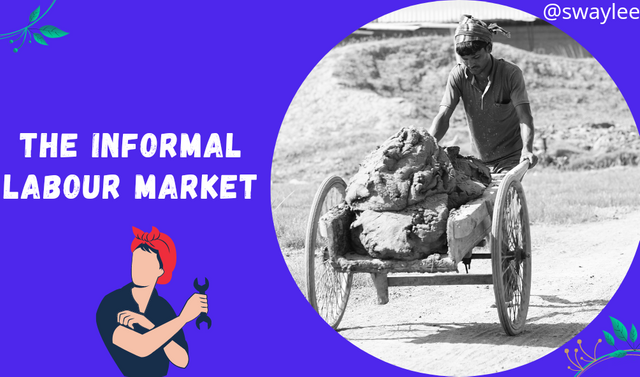

Greetings Everyone,
It's Rasheed once again with another learnwithsteem special edition which happens to be the continuation of a lecture I made earlier about introduction to the labour market. Today we would be looking at formal and informal labour markets and the difference between them. We would also be adding features of the Nigerian Labour Market to the post as a bonus to readers. It is sure to be an interesting lecture so please do well to read to the end and ask questions if possible.

Formal Sector

This sector deals with firms and jobs which are subject to stable employment, high wages, better working conditions, opportunities for training and advancement and institutionalized labour union activities and jobs with little or no supervision. They are mainly utilized for their skill, expertise and training and they usually get a higher pay for the level of skill and specialization they bring to the work area. They are usually referred to as white collar jobs and various examples government secretary, bankers, branch managers of a company and so on.
Informal Sector

This Sector deals with jobs which are subject to unstable patterns of employment (casual employment) and wage determination as well as low wages, poor working conditions, low levels of skills, very little training opportunities and little or no promotions if possible. They are usually referred to as brown collar jobs and usually require less skills and more of menial and physical activity or hard Labour. Examples include contraction jobs, brick laying, delivery jobs and so on.

Distinction between Formal and Informal Labour Markets
| Aspect | Formal Sector | Informal Sector |
|---|---|---|
| Competitiveness | It is characterized by highly qualified and upwardly mobile jobs in large scale enterprises which enjoy higher wages. | The reverse is the case here where there is little qualification requirements, casual labour, low wage access and poor working conditions. |
| Determination of wages | Wages and employment is handled by a protective institutional structure | Here employment and wage determination is handled by the forces of demand and supply |
| Mobility | Workers from this Sector can easily move between the both sectors | Workers here cannot easily move to the formal sector |
| Separation costs | Employers in this Sector have substantial turnover costs like severance payments and litigation in the court of law | Employers in the informal sectors are free from all these extra costs. |
| Changes in Employment | Here they adjust the hiring rate due to the permanent nature of their jobs | Here they simply lay off the workers by means of sacking |

Features Of The Nigerian Labour Market

Dualism in the labour market
Dualism here means that there is market segmentation into two Sectors, the formal and informal sectors as this post is talking about. The formal sector provides good working conditions, higher pay and so on while the informal sector is for casual workers with little pay and little job requirements.
Unemployment and underemployment
There is a large amount of unemployed citizens in the country with less industries to employ the idle labour, incompetent government to ensure paid employment above the minimum wage and overpopulation. There is also underemployment as people with degrees are working menial brown collar jobs which is far below their qualifications.
Cheap and Underpaid Labour
Due to the high level of idle labour in the country, some people are ready to settle for less even if it means getting half the original amount of wages they are due and employers take advantage of this to under pay staffs with the intention of replacing them if they aren't ready to work.
High population of the labour force
Due to the over population in the country, there is a large number of idle labour in the labour force which keeps growing rapidly.

Conclusion
Everyone is out there trying to make an honest living so whether you are in the formal sector, informal sector or unemployed, it's not good to look down at those working brown collar jobs as they are part of the system too. I hope we enjoyed today's lecture as it's a practical topic which we notice in our day to day activities and can totally relate and understand. Anticipate the next lecture and thanks for reading.

All unsourced images used in this post were made using Canva
10% to @campusconnectng
Thank you for contributing to #LearnWithSteem theme (#learnwithsteem , #tutorial, and #lesson). This post has been upvoted by @tucsond using @steemcurator09 account. We encourage you to keep publishing quality and original content in the Steemit ecosystem to earn support for your content.
Regards,
Team #Sevengers
Downvoting a post can decrease pending rewards and make it less visible. Common reasons:
Submit
Thank you very much for the support
Downvoting a post can decrease pending rewards and make it less visible. Common reasons:
Submit
Nice article you wrote here
Downvoting a post can decrease pending rewards and make it less visible. Common reasons:
Submit